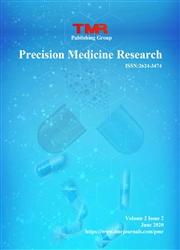Investigating the effect of rubiadin cytotoxicity and expression of BAX and BCL2 genes on HepG2 liver cancer cell line
引用次数: 0
Abstract
Background: Rubiadin is a type of anthraquinone compound that can be found in Rubiaceae plants, such as Ronas. Nonetheless, only limited research has been done to explore the potential anticancer properties of rubiadin on liver cancer cells. Thus, the objective of the present study is to examine how rubiadin affects the viability of liver cancer cells as well as normal cells. Methods: HepG2 and AGO cell lines were assigned into controls (not exposed to rubiadin) and groups with exposure to rubiadin with 12.5, 6.25, 3.125, 1.56, 0.78, and 0.39 μg/mL concentrations. 3-(4,5)-dimethylthiahiazo (-z-y1)-3,5-di-phenytetrazoliumromide and reverse transcription-polymerase chain reaction were used to measure cell viability, and one-way analysis of variance was used for data analysis. Results: The viability of liver cancer cells was significantly reduced when exposed to 12.5, 6.25, 3.125, and 1.56 μg/mL concentrations ( P < 0.01). An IC 50 of 44.73 μg/mL was reported. Furthermore, the BAX gene’s relative expression ( P < 0.05) was significantly increased and the BCL2 gene expression ( P < 0.05) was significantly reduced. The average ratio of BAX gene expression to BCL2 increased significantly ( P < 0.01). Conclusion: This research showed that rubiadin decreases cell viability by increasing the ratio of BAX gene expression to BCL2. In addition rubiadin has no cytotoxic effect on normal cells.探讨红宝石定对HepG2肝癌细胞毒性及BAX、BCL2基因表达的影响
背景:茜草素是茜草科植物中含有的一种蒽醌类化合物。然而,只有有限的研究做了探索红宝石对肝癌细胞的潜在抗癌特性。因此,本研究的目的是研究红宝石定如何影响肝癌细胞和正常细胞的活力。方法:将HepG2和AGO细胞系分为对照组(未接触rubbiadin)和浓度分别为12.5、6.25、3.125、1.56、0.78和0.39 μg/mL的rubbiadin暴露组。采用3-(4,5)-二甲基噻唑偶氮(-z-y1)-3,5-二苯四氮唑胺和逆转录聚合酶链反应测定细胞活力,采用单因素方差分析进行数据分析。结果:肝癌细胞在12.5、6.25、3.125、1.56 μg/mL浓度下的存活率均显著降低(P < 0.01)。ic50为44.73 μg/mL。BAX基因相对表达量显著升高(P < 0.05), BCL2基因表达量显著降低(P < 0.05)。BAX基因与BCL2的平均表达比显著升高(P < 0.01)。结论:本研究表明红宝石素通过提高BAX基因与BCL2基因的表达比而降低细胞活力。此外,rubadin对正常细胞无细胞毒性作用。
本文章由计算机程序翻译,如有差异,请以英文原文为准。
求助全文
约1分钟内获得全文
求助全文

 求助内容:
求助内容: 应助结果提醒方式:
应助结果提醒方式:


